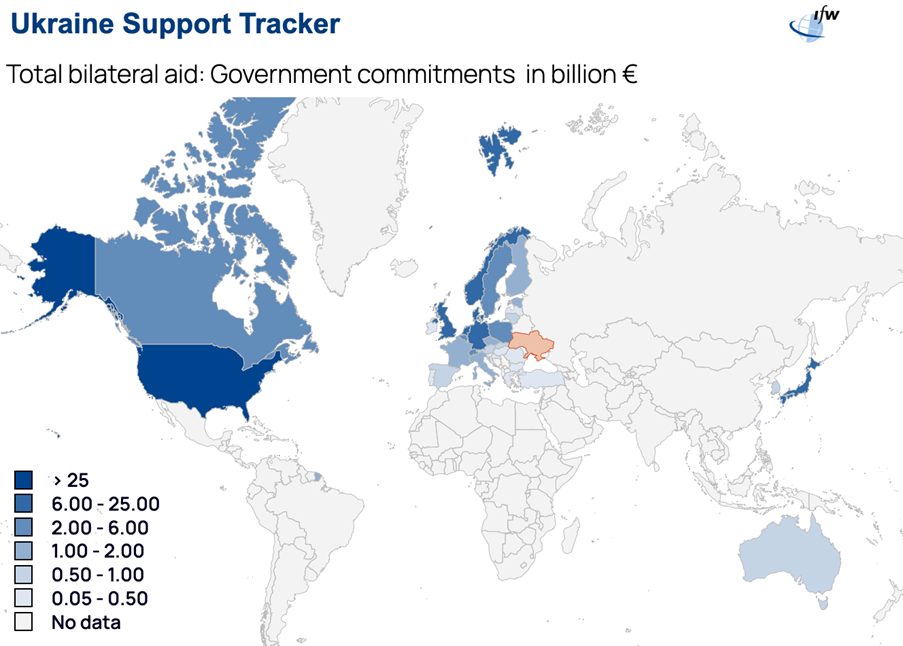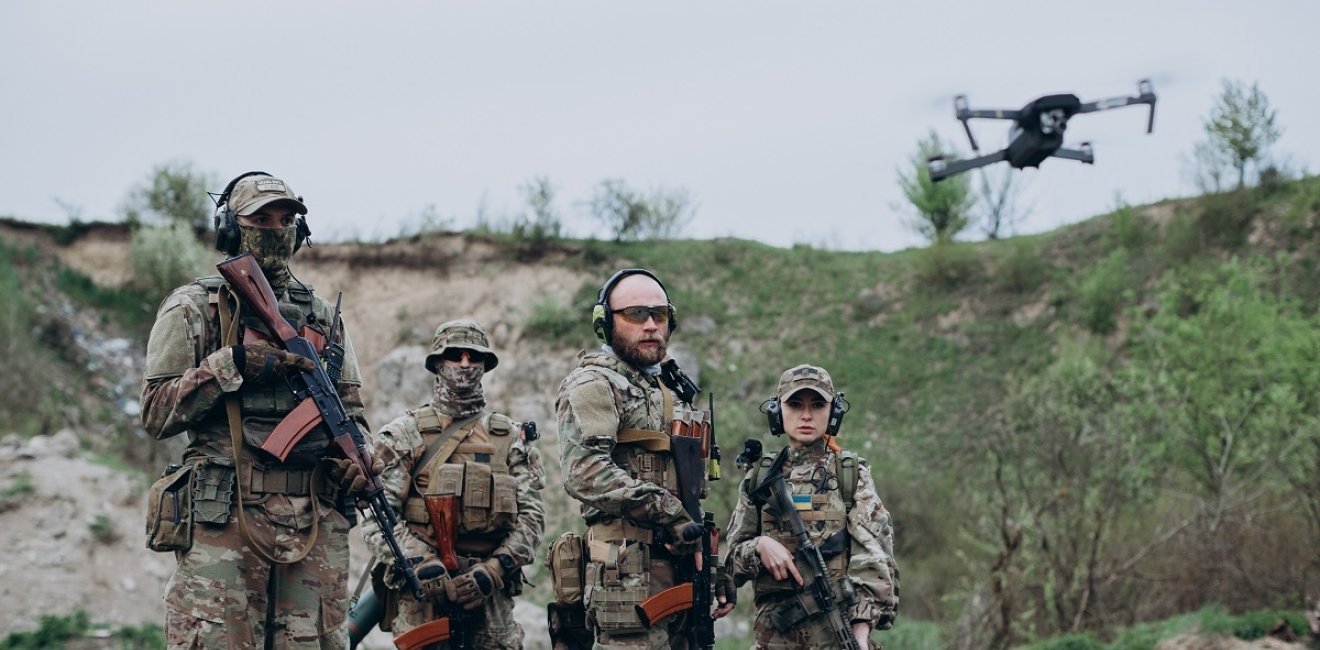
A blog of the Kennan Institute
The mood in Ukraine before the US House of Representatives approved the Ukraine Security Supplemental Appropriations Act on April 20 had become increasingly somber. President Zelensky pinpointed the underlying problem when he said that without American support, the Ukrainian Armed Forces (UAF) could not win the war and would be forced to retreat, while Ukraine itself might not survive as a sovereign nation. The delay in US support for Ukraine did not change Ukrainians’ belief in victory but did add a certain fatalism to this conviction. Now that the debates in Washington on providing aid to Ukraine are mostly over, the situation on the ground in Ukraine should change for the better.
The West’s Debates on Supporting Ukraine
The US Congress started debating the provision of military and financial assistance in September 2023. That month, President Zelensky visited Congress with a message on the signal importance of American aid to UAF success in defending against Russian attacks. With Hamas’s October 7 attack on Israel and the start of the Gaza war, military assistance packages for Ukraine and for Israel were tied together in a single bill. That bill was later expanded to include aid for Taiwan and proposed changes to immigration policy on the US-Mexico border. By January 2024, crafting an assistance bill that would satisfy both parties in Congress and many factions in D.C. looked nigh impossible.
With the ongoing debates in Washington seemingly yielding no solution and with Ukraine’s defense in jeopardy, the EU member states approved a $54 billion aid package in February 2024. In March the EU added an additional $5 billion in military assistance for Ukraine.
The Picture of Ukrainian Aid in Early 2024
In total, from January to early April 2024, Ukraine received financial aid in the form of both grants and loans in excess of US $13 billion. That sum included loans from the EU ($4.9 billion), Canada ($1.5 billion), and Japan ($1.1 billion), and an $880 million IMF loan tranche. In the winter of 2023–2024 and the spring of 2024, Berlin considerably increased its military support for Ukraine, becoming Kyiv’s second-largest defense partner. Japan, Norway, and the UK are also among Ukraine’s biggest supporters.
In general, the map of Ukraine’s partners looks like this:

Source: Ukraine Support Tracker, Kiel Institute for World Economy (as of April 19, 2024)
Although these many packages of support have allowed Ukraine to stand strong in the war over the past six months, they could not fully substitute for the delayed U.S. military and financial aid.
Last week, the factions in the US Congress finally hit on a compromise: military and financial assistance to Ukraine is to be provided in the form of a “forgivable loan.” President Zelensky has agreed to such a compromise solution. The ever-increasing hits on Ukraine’s energy sector and critical infrastructure in the recent past have meant that further delays in US military support could not be tolerated.
Details of the Ukraine Security Supplemental Appropriations Act
The approved bill allocates funds from the US federal budget for fiscal year 2024 in the form of “supplemental appropriations for federal departments and agencies to respond to the conflict in Ukraine.” According to the official document, the act provides resources for supporting US military operations in Europe, funding the Ukraine Security Assistance Initiative, and funding the Foreign Military Financing Program. It also covers “replacing defense articles that were provided to Ukraine” in recent months and reimburses the Department of Defense “for defense services and training provided to Ukraine.” The act also provides a certain amount of economic support for the Ukrainian state budget.
The funding under this act includes:
- Over $23 billion for replenishing US weapons, stocks and facilities;
- Over $11 billion for US training of UAF servicemen and women;
- Almost $14 billion for the purchase of advanced weapons systems for Ukraine; and
- $9 billion in repayable economic assistance (which cannot be used for social payments in Ukraine).
After the Senate approves the bill and President Biden signs it, this act will add over $60 billion in funding to the previous $75 billion in US commitments. The total US investment in Ukraine’s defense and economic survival will then exceed $130 billion.
Requirements Attached to the Bill. The approved bill has some specific requirements. For example, it requires the US president to transfer long-range Army Tactical Missile Systems (ATACMS) to the UAF. And it expects other partners of Ukraine—from the EU, NATO, or the G7 countries—to match some of the US funding. It requests the US administration to develop and impose better “oversight and reporting requirements for assistance provided to Ukraine.” Finally, the bill requires the US government to ensure that Ukraine repays the funds provided by the United States under this act.
The Act Improves Ukraine’s Security and Sociopolitical Situation
As the United States resumes its robust support of Ukraine’s defense of that country’s existence, independence, and freedom, the situation on the ground will definitely improve. The Pentagon has already prepared a new military aid package for the UAF. With an enhanced arsenal, Ukraine will be able to increase its defensive military operations on the front line and attempt to reverse the Russian Armed Forces’ steady progress in the Donbas.
Most important, the US aid package shores up the ability of the Ukrainian leadership to plan its defense operations and economic steps for the next ten to twelve months. The strengthened US-Ukraine partnership is a critically important factor in bettering the security and sociopolitical situation of this country at war.
The opinions expressed in this article are those solely of the author and do not reflect the views of the Kennan Institute.
Author


Kennan Institute
The Kennan Institute is the premier US center for advanced research on Eurasia and the oldest and largest regional program at the Woodrow Wilson International Center for Scholars. The Kennan Institute is committed to improving American understanding of Russia, Ukraine, Central Asia, the South Caucasus, and the surrounding region through research and exchange. Read more

Explore More in Focus Ukraine
Browse Focus Ukraine
Smart Take | Congress Sends Russia a Message by Passing US Aid Package for Ukraine

Talking to the Dead to Heal the Living

Ukrainian Issue in Polish Elections

